As autumn arrives, trees become nature’s artists, bursting with vivid colors. Dive into our list of 21 trees that steal the fall show, paired with their ideal planting spots.
Transform your yard into a radiant seasonal spectacle with these vibrant, leaf-dropping wonders.
1. Sugar Maple
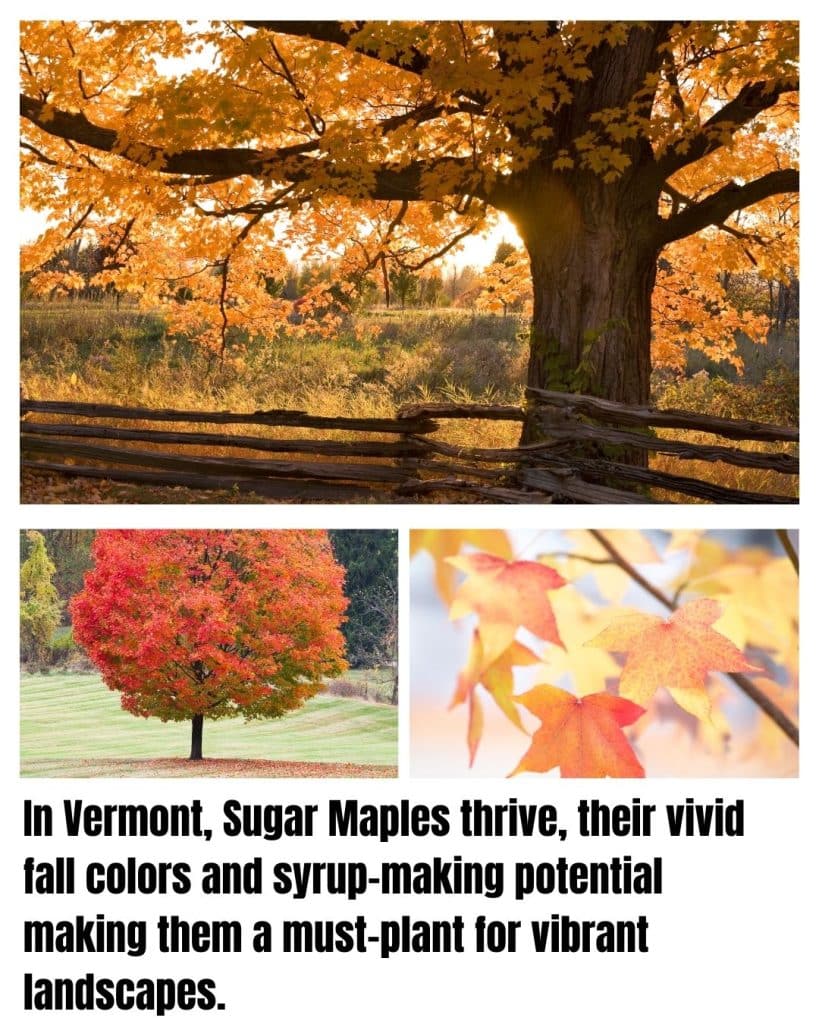
- Thrives in: USDA hardiness zones 3-8, particularly in the northeastern United States like New England and the Midwest, where it prefers cool climates with cold winters, moderate summers, and deep, well-drained, slightly acidic soils with full sun to partial shade.
- Leaf show: A stunning spectacle of vibrant reds, oranges, and yellows that can vary based on soil and weather, often peaking in mid-October for a fiery, multi-hued canopy.
- Did You know? It’s the source of maple syrup, with sap tapped in early spring; a single mature tree can produce up to 10-20 gallons of sap per season, which boils down to about a quart of syrup.
The Sugar Maple (Acer saccharum) is a stately hardwood native to eastern North America, growing 60-100 feet tall with a rounded crown that offers dense summer shade.
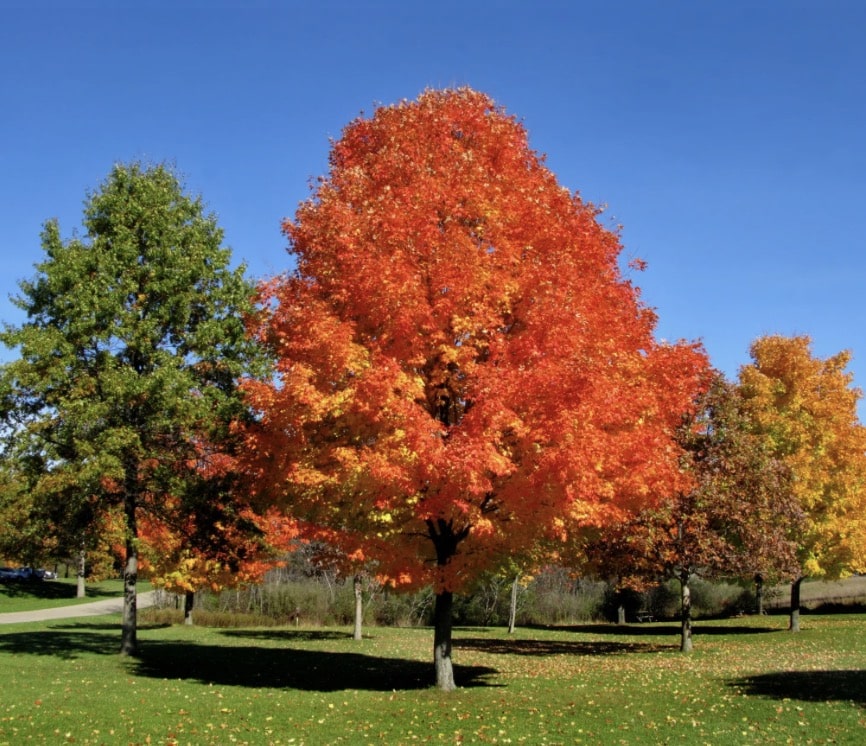
Its smooth gray bark matures into furrowed ridges, and in spring, inconspicuous yellow-green flowers give way to winged seeds.
Ideal for large landscapes, it tolerates urban conditions moderately but dislikes salt, compaction, or drought.
Beyond aesthetics, it’s ecologically vital, supporting wildlife like squirrels and birds. Plant in fertile soil for optimal growth; it’s slow to establish but lives 200+ years, becoming a legacy tree for generations.
2. Red Maple
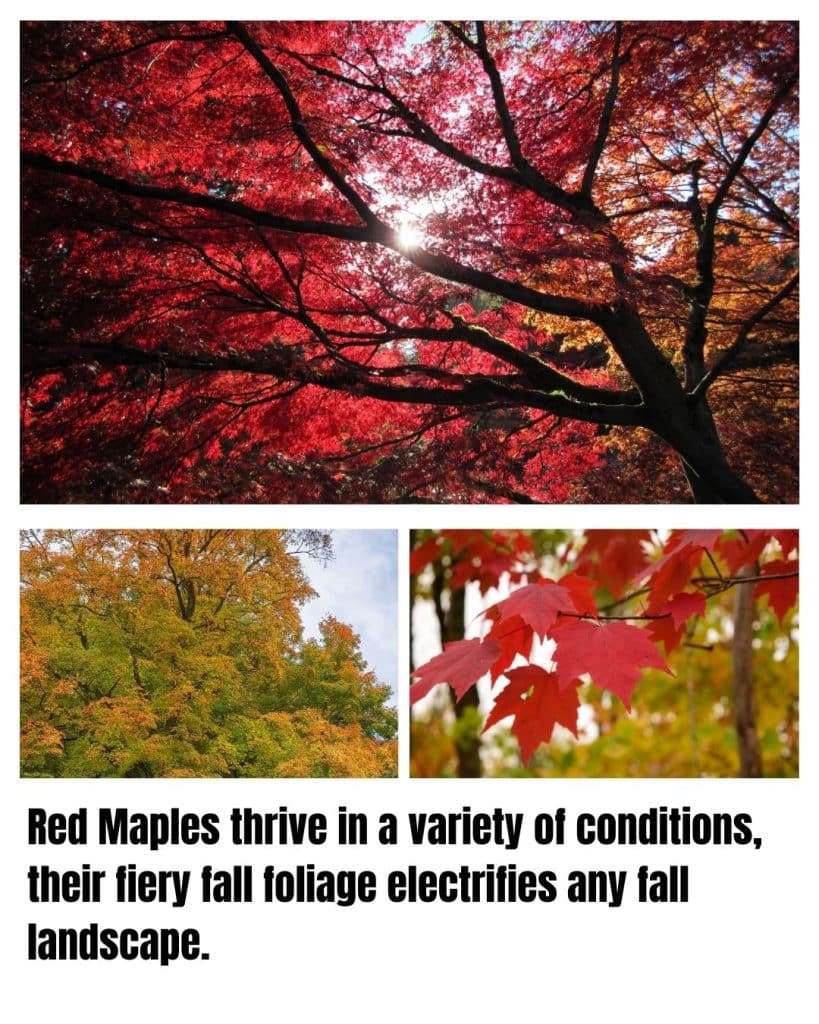
- Thrives in: USDA hardiness zones 3-9, across eastern North America, favoring moist, slightly acidic soils in wetlands, swamps, or uplands, adaptable to full sun or partial shade.
- Leaf show: Brilliant scarlet, orange, and yellow foliage in fall, with vibrant red hues dominating in cooler climates, peaking in early to mid-October for a striking display.
- Trivia: Its red buds, flowers, and seeds add year-round color, and it’s one of the first trees to bloom in spring, often by late February.
The Red Maple (Acer rubrum) is a versatile, fast-growing tree native to eastern North America, it reaches 40-70 feet with a rounded or oval crown.
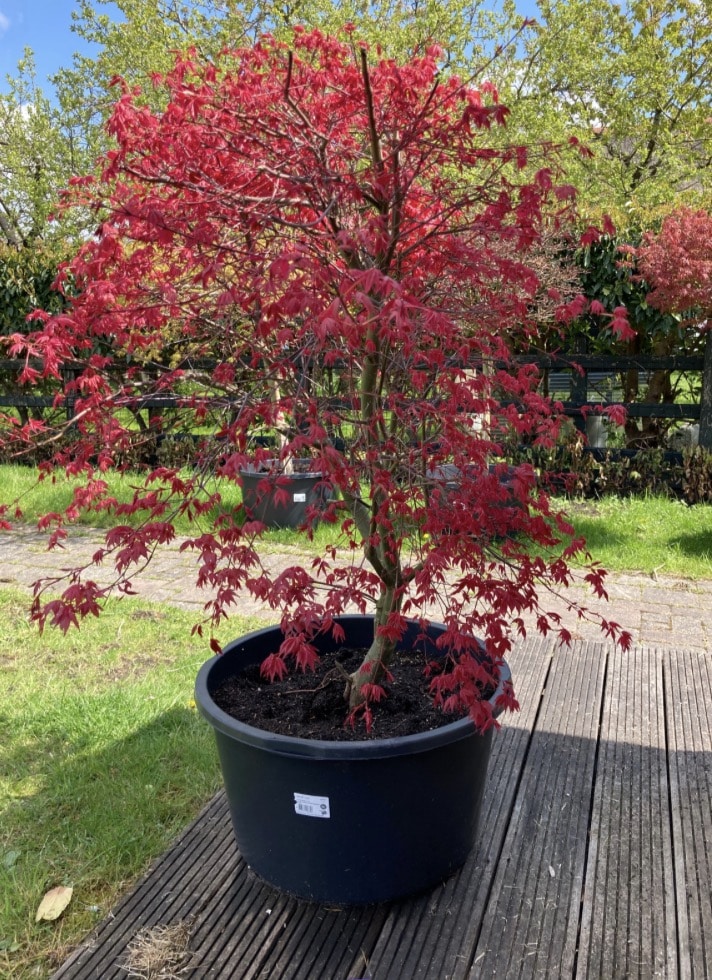
Its smooth gray bark becomes scaly with age, and its red-tinged flowers attract early pollinators.
Adaptable to various soils, it tolerates wet conditions and urban pollution better than most maples.
Ideal for medium to large landscapes, it supports wildlife like birds and squirrels. Plant in moist, well-drained soil for best growth; it lives 80-100 years.
3. Black Gum
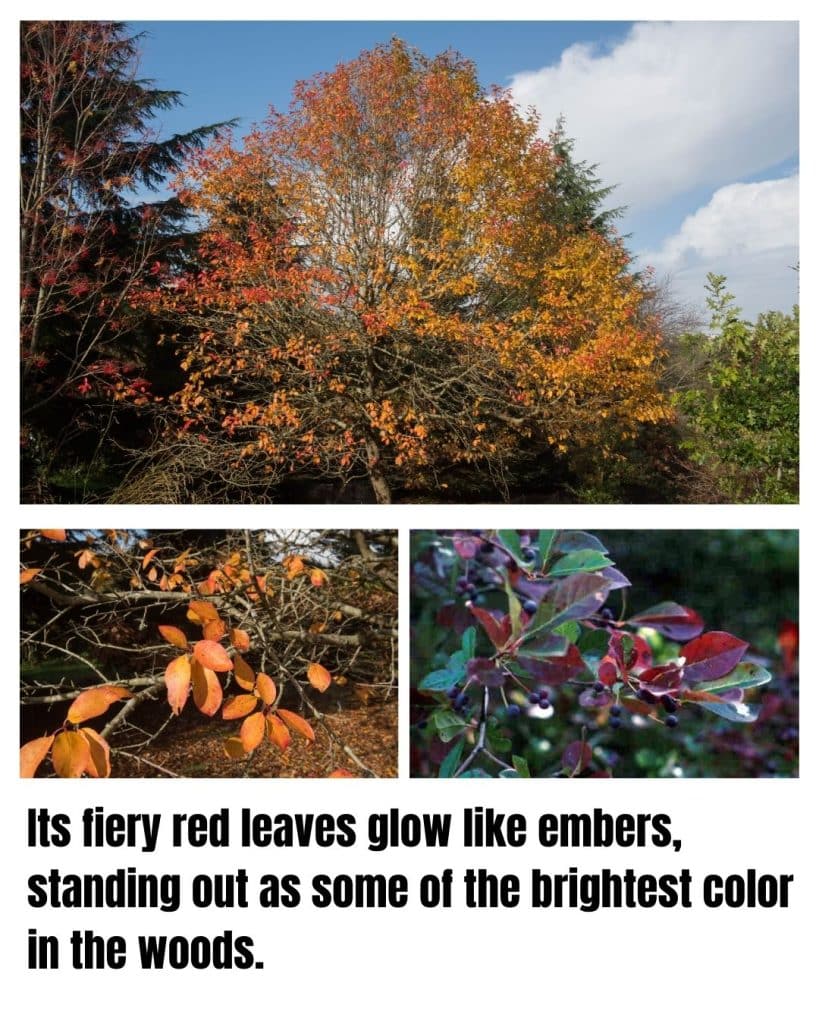
- Thrives in: USDA hardiness zones 4-9, native to eastern North America, preferring moist, well-drained, acidic soils in full sun to partial shade, but adaptable to wet or dry conditions.
- Leaf show: Glossy leaves turn brilliant scarlet, deep purple, and orange in early fall, often one of the first trees to change, creating a vibrant, prolonged display.
- Trivia: Also known as tupelo, its dark, juicy berries are a key food source for birds, and its honey is prized for its unique flavor.
The Black Gum (Nyssa sylvatica), a native hardwood, grows 30-50 feet tall with a pyramidal or rounded crown, offering dense shade.
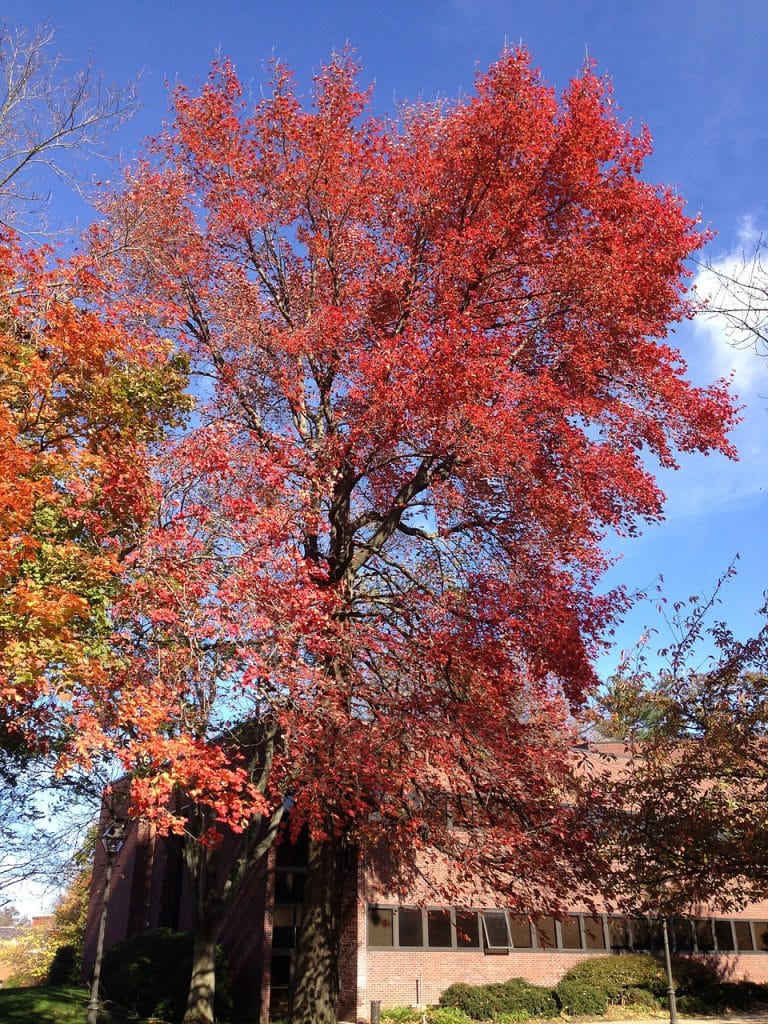
Its smooth, dark bark and glossy green leaves transform into a stunning early fall spectacle.
Highly adaptable, it tolerates flooding, drought, and poor soils, making it ideal for diverse landscapes.
Its strong wood resists wind damage, and it supports wildlife like bees and songbirds.
Slow-growing but long-lived (up to 250 years), it’s a low-maintenance choice for striking fall beauty.
4. Japanese Maple
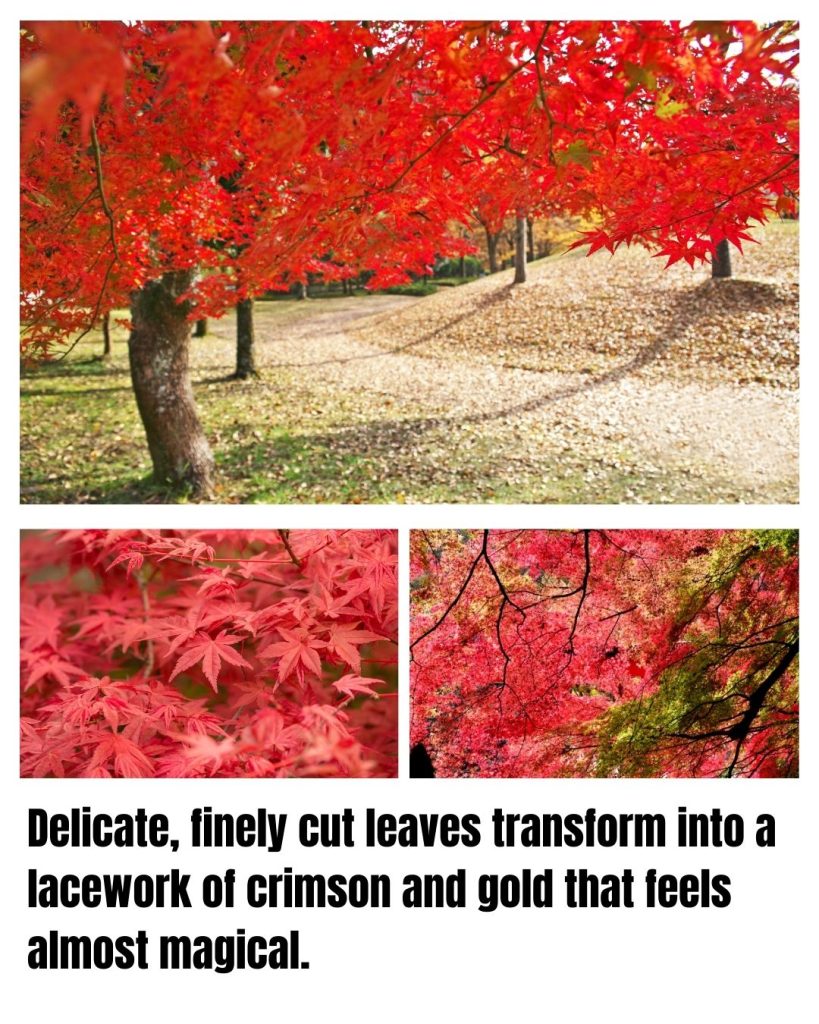
- Thrives in: USDA hardiness zones 5-8, preferring well-drained, slightly acidic soils in partial shade, though some cultivars tolerate full sun; ideal for temperate climates with moderate summers.
- Leaf show: Delicate, lacy leaves turn vivid crimson, orange, or yellow in fall, with colors varying by cultivar, creating a dazzling, layered display from October to November.
- Did you know? With over 1,000 cultivars, Japanese Maples range from dwarf shrubs to small trees, often used in bonsai for their graceful form and intricate foliage.
The Japanese Maple (Acer palmatum) is a small, ornamental tree, typically growing 15-25 feet, prized for its elegant, arching branches and finely cut leaves.
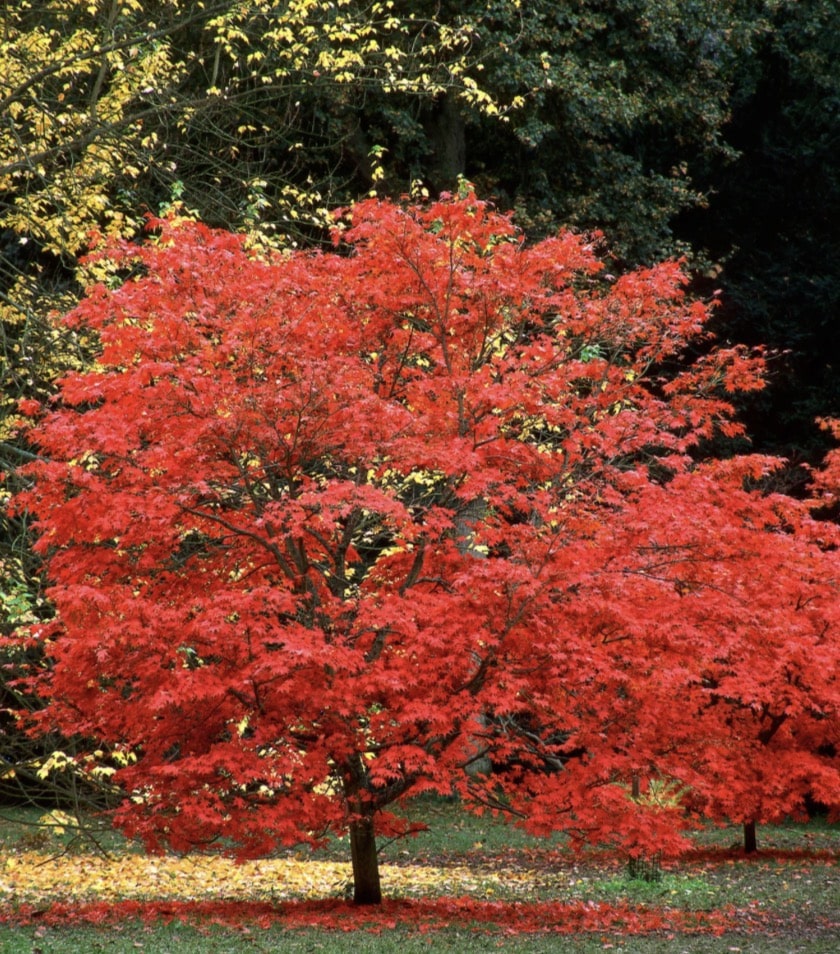
Native to East Asia, it thrives in sheltered landscapes, offering year-round beauty with spring blooms and winged seeds.
Adaptable to containers or small gardens, it prefers protection from harsh winds and intense afternoon sun.
Low-maintenance and pest-resistant, it supports minimal wildlife but adds refined charm, living 60-100 years with proper care.
5. Ginkgo
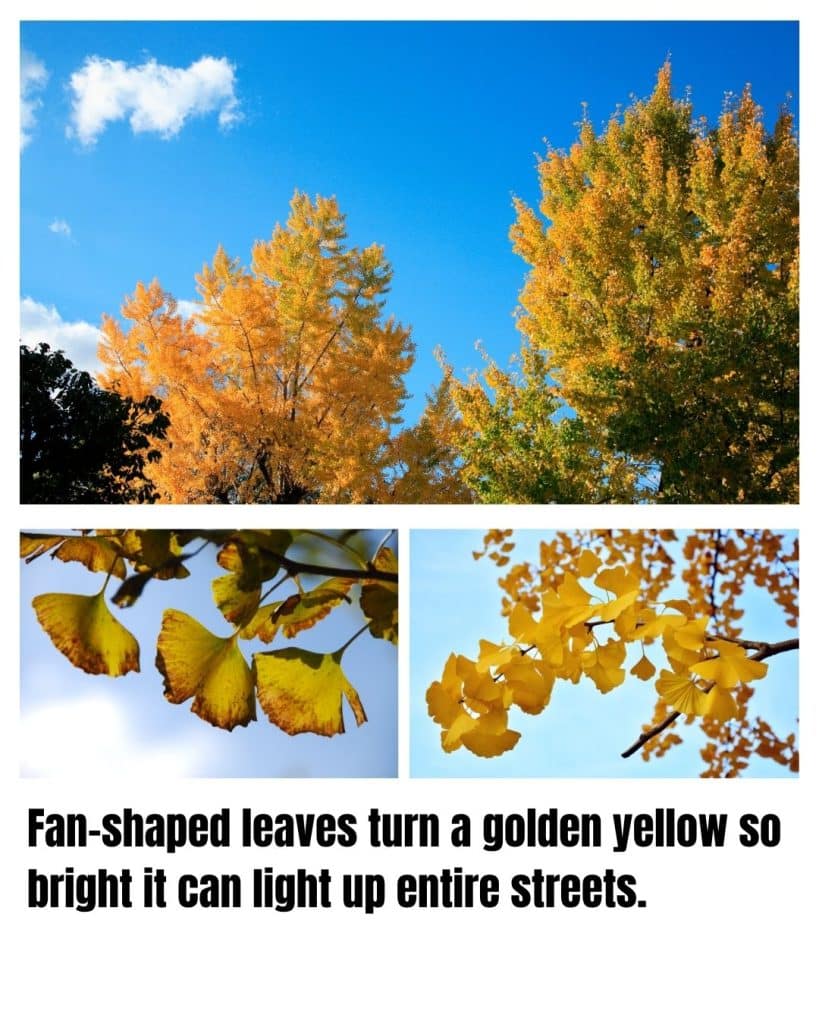
- Thrives in: USDA hardiness zones 3-8, adaptable to various soils, including urban environments, preferring full sun and well-drained conditions; tolerates pollution, salt, and drought.
- Leaf show: Fan-shaped leaves turn a brilliant, uniform golden-yellow in mid to late fall, often dropping all at once in a stunning golden carpet effect.
- Believe it or not… One of the oldest tree species, dating back 270 million years, Ginkgo biloba is a living fossil, with no close living relatives.
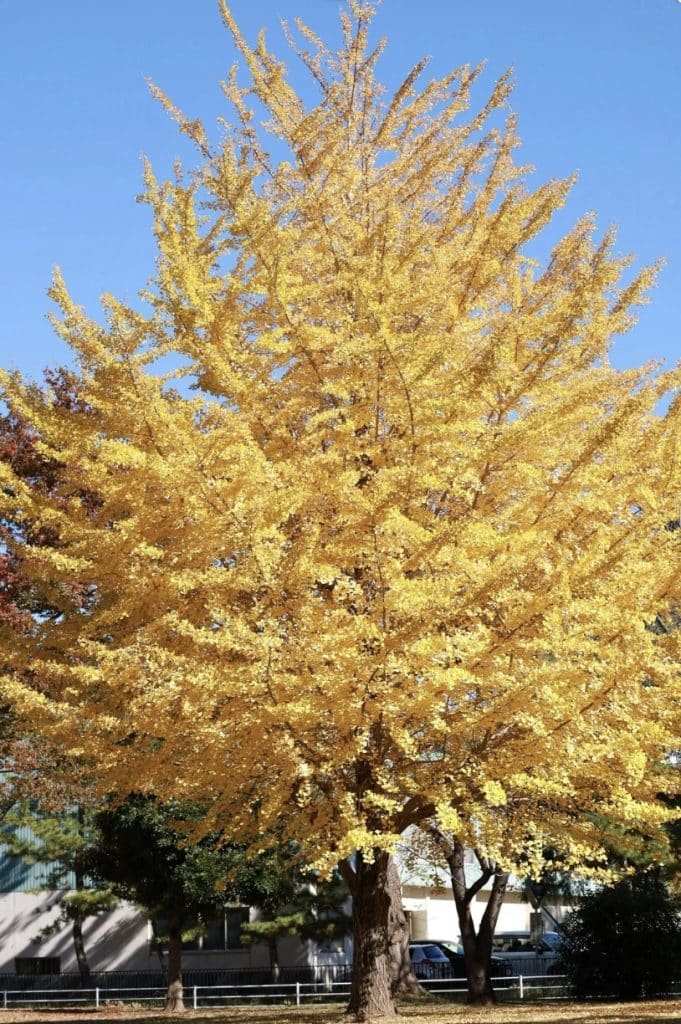
The Ginkgo (Ginkgo biloba) is a resilient, deciduous tree native to China, growing 50-80 feet with a conical or spreading crown.
Its unique, fan-shaped leaves and furrowed gray bark add architectural interest. Ideal for urban settings, it resists pests and diseases, thriving in poor soils.
Female trees produce foul-smelling fruit, so male cultivars are preferred.
Slow-growing but long-lived (up to 1,000 years), it supports minimal wildlife but offers striking beauty and historical intrigue for diverse landscapes.
6. Sweetgum
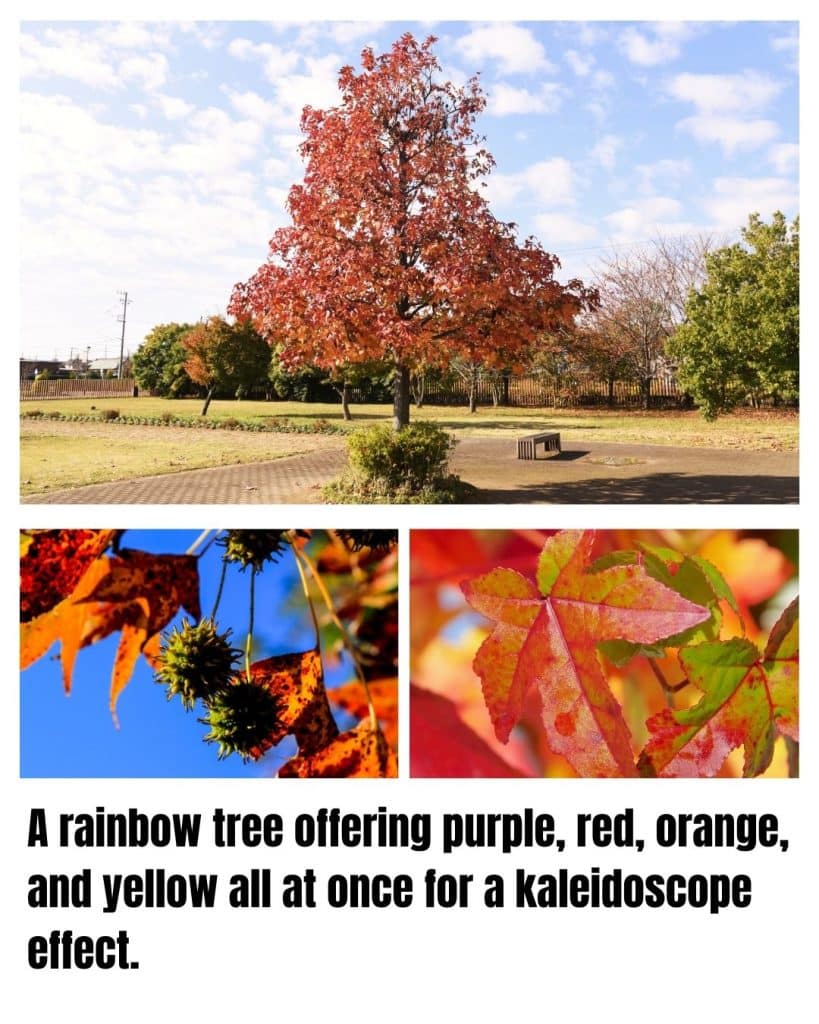
- Thrives in: USDA hardiness zones 5-9, native to the Eastern US and Canada, preferring moist, well-drained, slightly acidic soils in full sun, but adaptable to clay or wet conditions.
- Leaf show: Star-shaped leaves turn vibrant red, purple, orange, and yellow in fall, often displaying multiple colors on a single tree for a spectacular, prolonged display.
- Be prepared to get poked: Its spiky seed balls, called “gumballs,” are used in crafts, but can be a nuisance on lawns; the tree’s sap was historically chewed as gum.
The Sweetgum (Liquidambar styraciflua) is a tall, native hardwood, growing 60-100 feet with a pyramidal crown that matures to oval.
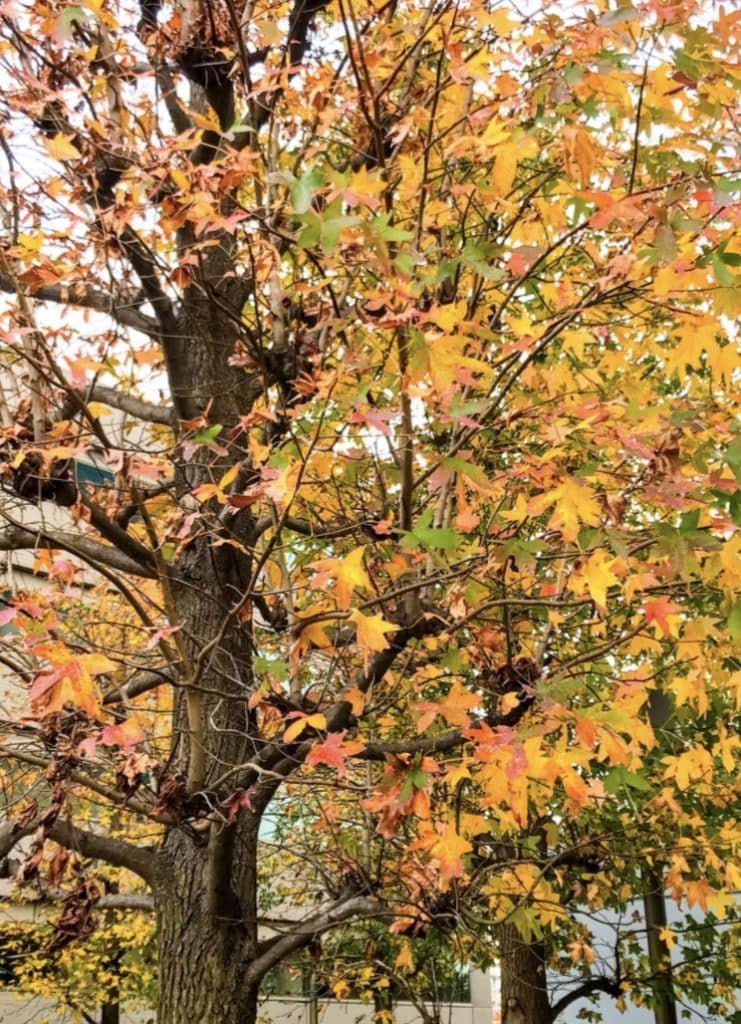
Its glossy, star-shaped leaves and corky bark add year-round appeal. Ideal for large landscapes, it tolerates wet soils and moderate urban stress but dislikes drought.
Fast-growing and long-lived (up to 150 years), birds and small mammals love it. Plant in spacious areas to avoid gumball litter; it’s a bold choice for vibrant fall color.
7. Shumard Oak
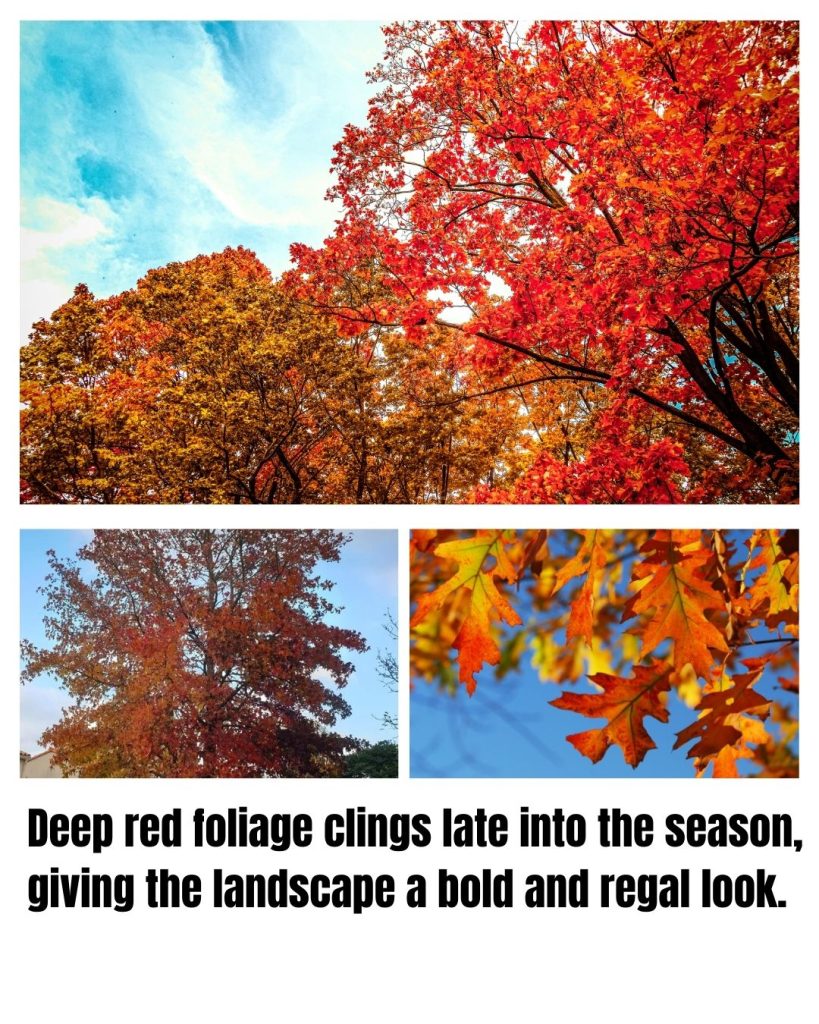
- Thrives in: USDA hardiness zones 5-9, native to the southeastern U.S., preferring deep, fertile, well-drained soils in full sun, but adaptable to clay or moist conditions.
- Leaf show: Large, lobed leaves turn brilliant red to reddish-orange in late fall, often holding color into November, creating a bold, fiery canopy.
- Trivia: Named after Texas geologist Benjamin Shumard, its strong wood is used for furniture, and its acorns are a vital food source for wildlife like deer and turkeys.
The Shumard Oak (Quercus shumardii) is a majestic, fast-growing tree, reaching 60-100 feet with a broad, rounded crown. Native to the Southeast, its dark green, glossy leaves and grayish bark add stately elegance. Ideal for large landscapes, it tolerates urban conditions and moderate drought but prefers moist, loamy soils.
Long-lived (up to 200 years), it supports diverse wildlife, including birds and mammals. Plant in open spaces for its grandeur and vibrant fall display.
8. Red Oak
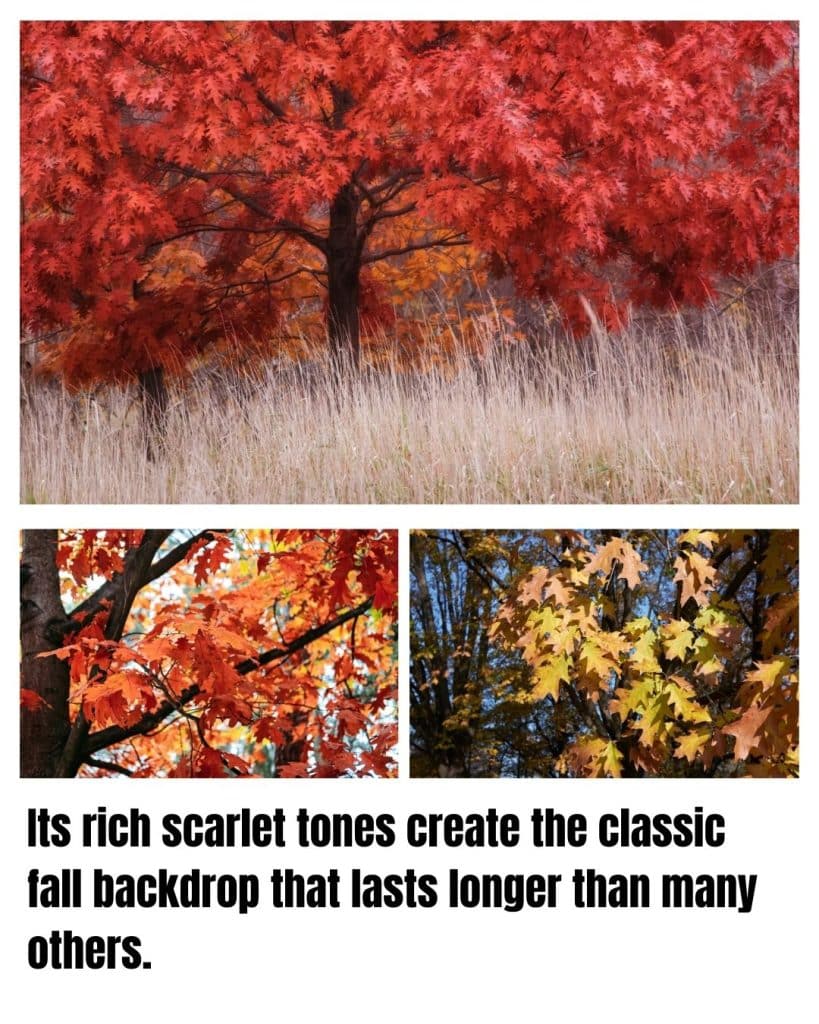
- Thrives in: USDA hardiness zones 4-8, native to eastern North America, preferring well-drained, slightly acidic soils in full sun, adaptable to sandy or clay conditions.
- Leaf show: Broad, lobed leaves turn deep red to scarlet in late fall, peaking in November, offering a bold, consistent display across diverse climates.
- An incredibly usesful tree: Its acorns, maturing in two years, are a key food for squirrels and deer; the wood is prized for flooring and furniture due to its strength.
The Red Oak (Quercus rubra) is a stately, fast-growing tree, reaching 60-80 feet with a rounded crown, native to eastern North America.
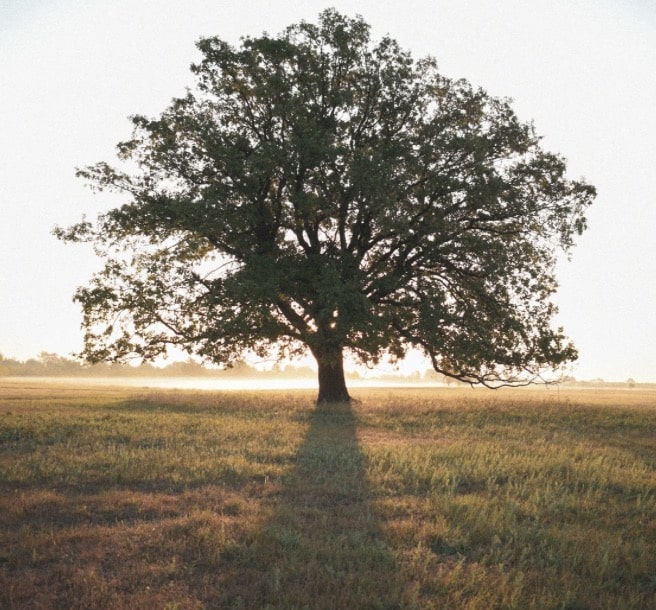
Its dark green leaves and smooth gray bark mature into rugged textures. Ideal for large landscapes, it tolerates urban pollution and moderate drought but prefers loamy soils.
Long-lived (up to 300 years), it supports wildlife like birds and mammals. Plant in spacious areas for its robust structure and vibrant fall color.
9. White Oak
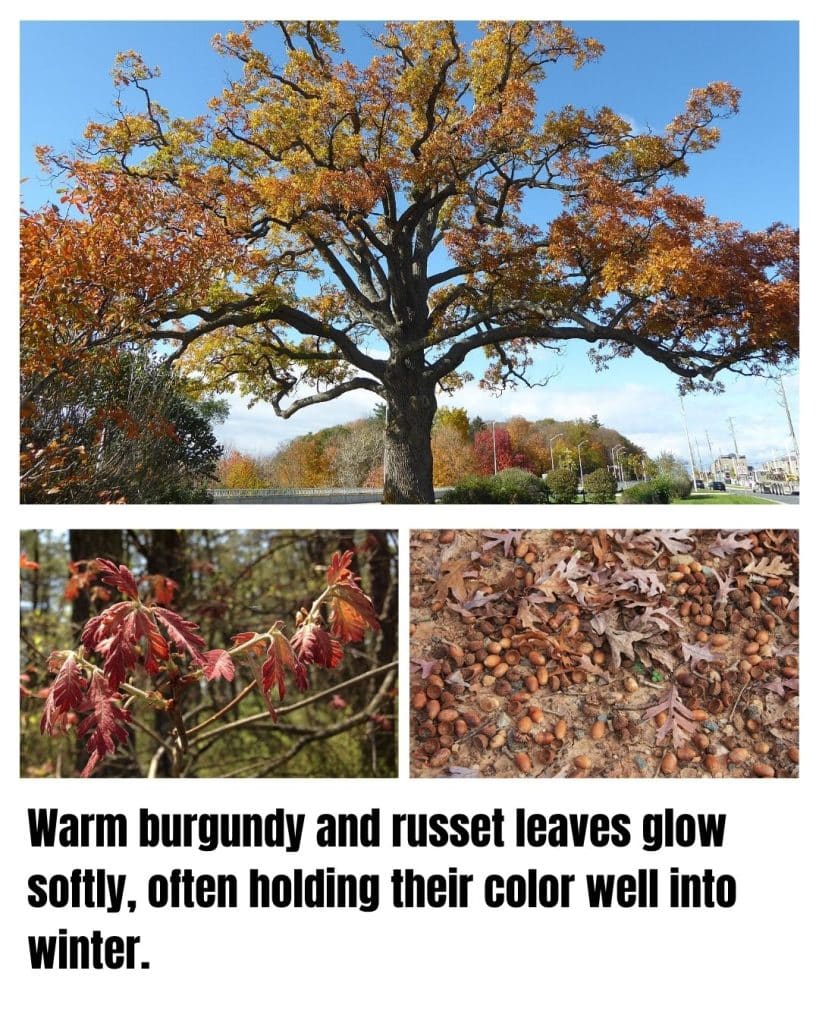
- Thrives in: USDA hardiness zones 3-9, native to eastern North America, preferring deep, moist, well-drained soils in full sun, but adaptable to various soil types.
- Leaf show: Lobed leaves turn rich red, burgundy, or purple in late fall, peaking in November, creating a warm, elegant display that persists longer in milder climates.
- The BEST acorns: Its acorns are sweeter than other oaks, attracting wildlife like deer and turkeys; its durable wood is used for barrels, especially for whiskey aging.
The White Oak (Quercus alba) is a majestic, slow-growing tree, reaching 60-100 feet with a broad, rounded crown.
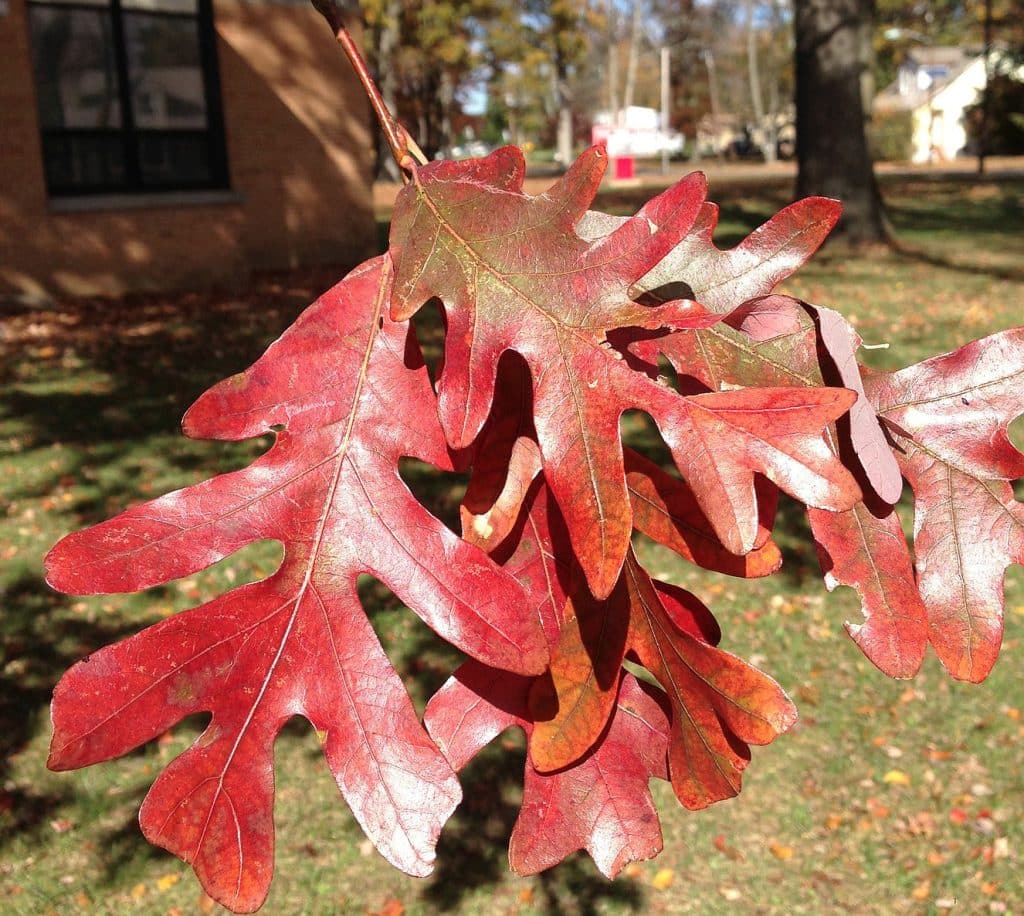
Native to eastern North America, its light gray, scaly bark and lush green leaves add timeless beauty. Ideal for large landscapes, it tolerates moderate urban conditions but prefers fertile soils.
Long-lived (up to 400 years), it supports diverse wildlife, including birds and mammals. Plant in open spaces for its grandeur and stunning fall color.
10. Dogwood
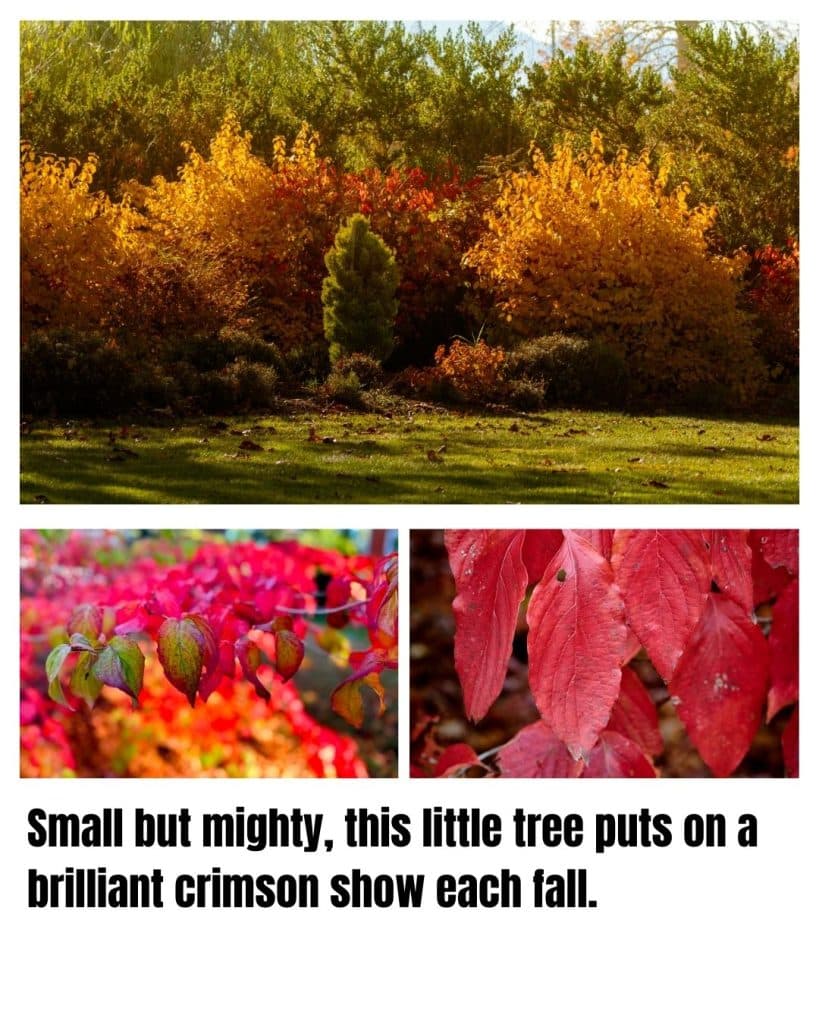
- Thrives in: USDA hardiness zones 5-9, native to eastern North America, preferring well-drained, slightly acidic soils in partial shade to full sun, ideal for understory or open settings.
- Leaf show: Oval leaves turn vibrant red to purplish-red in fall, complemented by bright red berries, creating a striking display from September to October.
- Did you know? Its spring flowers, often mistaken for petals, are actually bracts; the tree’s wood is so hard it was historically used for tool handles.
The Dogwood (Cornus florida) is a small, deciduous tree, growing 20-40 feet with a spreading, low-branching crown.
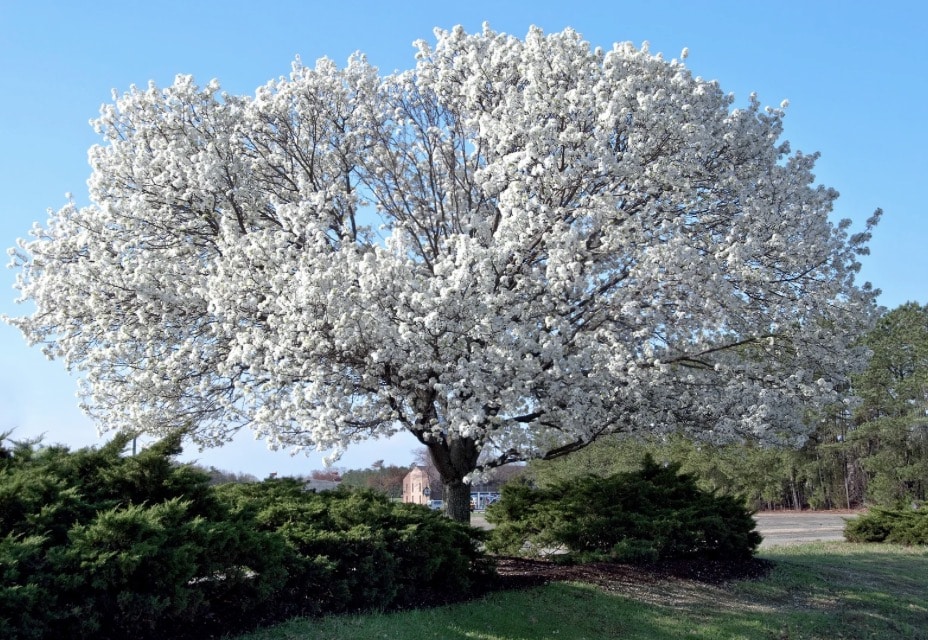
Native to eastern North America, its showy spring blooms and glossy green leaves add multi-season appeal. Ideal for small gardens or woodland edges, it tolerates shade but prefers moist, fertile soils.
It supports wildlife like birds, which feast on its berries. Moderately long-lived (up to 80 years), plant it for delicate beauty and vivid fall color.
11. Sassafras

- Thrives in: USDA hardiness zones 4-9, native to eastern North America, preferring well-drained, sandy, or loamy soils in full sun to partial shade, adaptable to various conditions.
- Leaf show: Unique, mitten-shaped leaves turn brilliant orange, red, and yellow in fall, creating a fiery, multi-hued display from September to October.
- The root in root beer: Its roots were historically used to make root beer, and its aromatic leaves and bark release a spicy scent when crushed.
The Sassafras (Sassafras albidum) is a medium-sized deciduous tree, growing 30-60 feet with a slender, irregular crown.
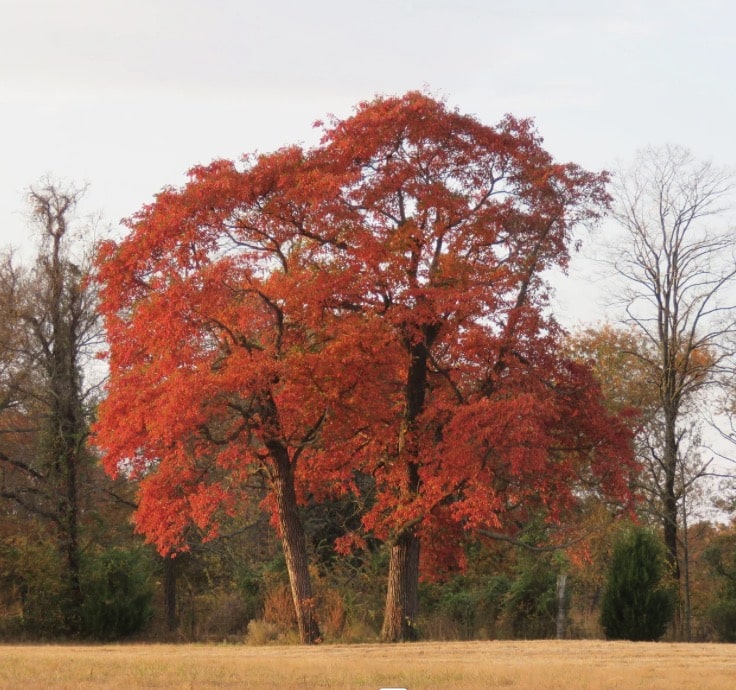
Native to eastern North America, its variable leaf shapes and smooth, reddish bark add quirky charm. Ideal for open landscapes or woodland edges, it tolerates poor soils but prefers moist, acidic conditions.
Fast-growing and moderately long-lived (up to 100 years), it supports wildlife like birds and butterflies.
Plant for its unique foliage and vibrant fall spectacle.
12. Quaking Aspen
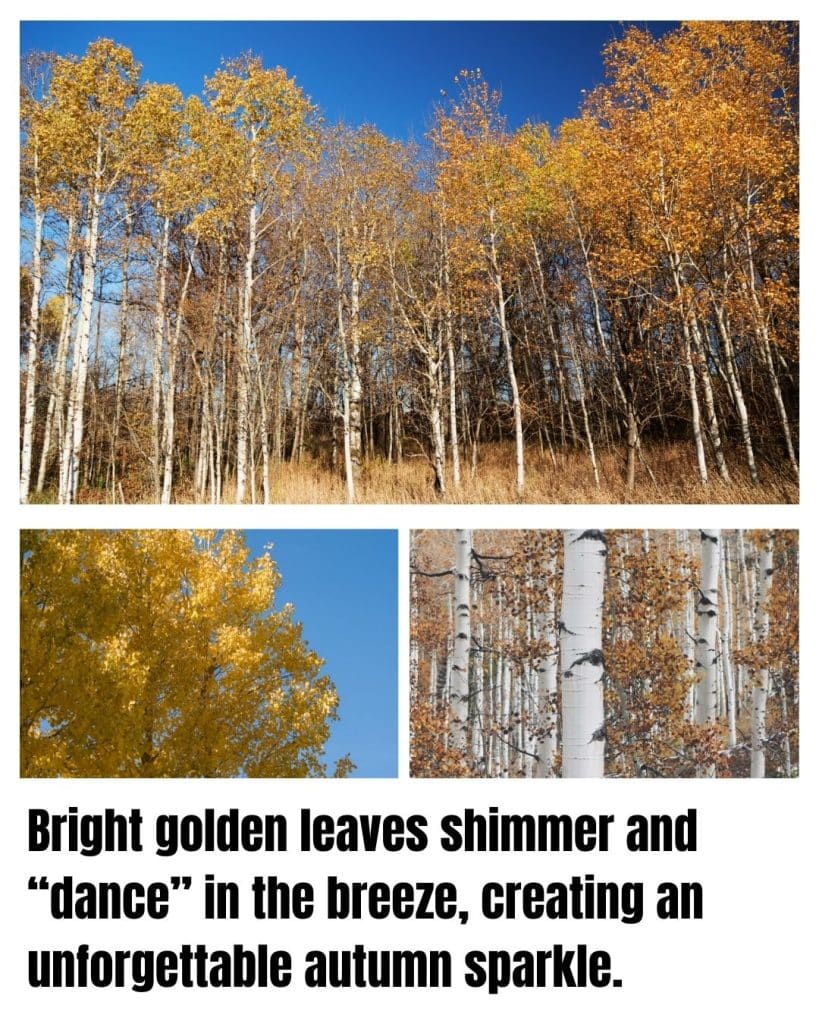
- Thrives in: USDA hardiness zones 1-6, native to northern and western North America, preferring moist, well-drained soils in full sun, often found in cooler, mountainous regions.
- Leaf show: Round leaves flutter in the breeze, turning a brilliant golden-yellow in early fall, often with hints of orange, creating a shimmering, glowing display.
- Trivia: Its trembling leaves, caused by flat petioles, give it the name “quaking”; it’s one of the largest living organisms, with clonal groves sharing a single root system.
The Quaking Aspen (Populus tremuloides) is a slender, fast-growing tree, reaching 20-50 feet with a narrow, rounded crown.
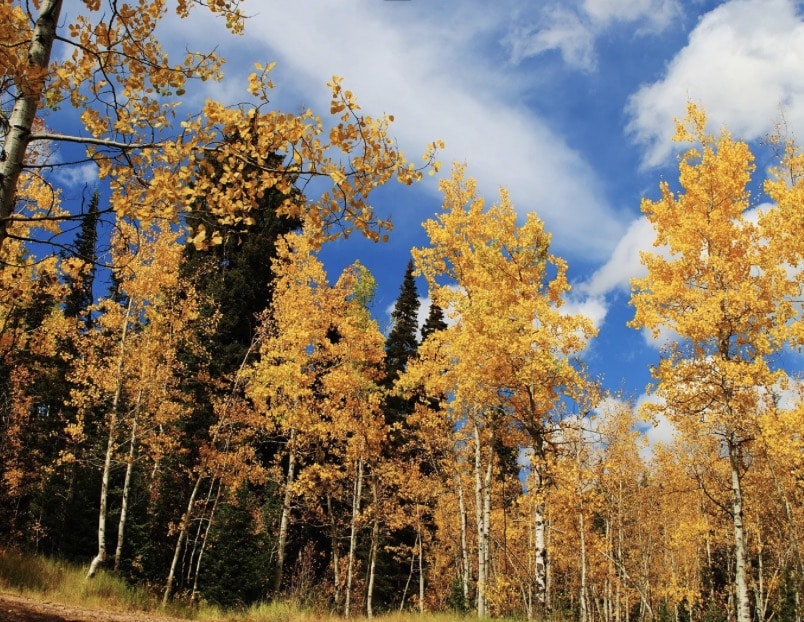
Native to North America, its smooth, white bark and heart-shaped leaves add delicate beauty. Ideal for open landscapes, it tolerates cold climates but struggles in heat or drought.
Short-lived (50-100 years), it supports wildlife like deer and birds. Plant in cool, moist areas for its iconic trembling leaves and vibrant fall color.
13. River Birch
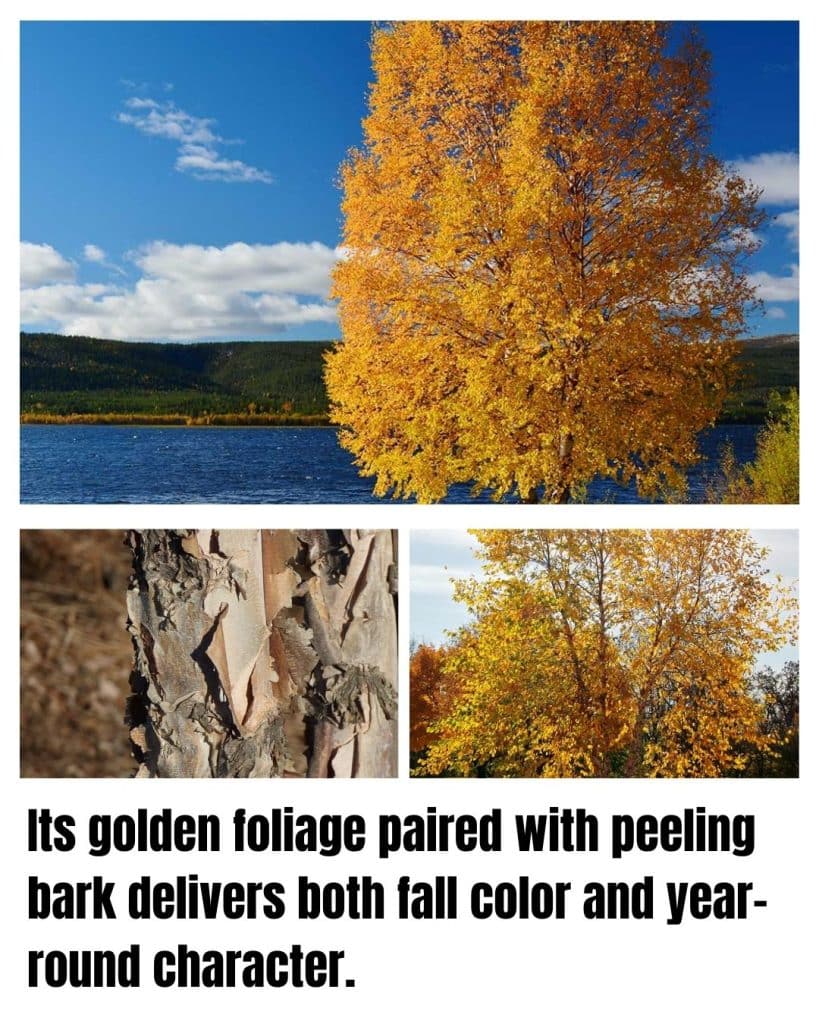
- Thrives in: USDA hardiness zones 4-9, native to eastern United States, preferring moist, well-drained, acidic soils in full sun to partial shade, often near streams or wetlands.
- Leaf show: Diamond-shaped leaves turn golden-yellow in fall, peaking in October, with peeling, cinnamon-colored bark adding year-round visual interest.
- Trivia: Its exfoliating bark, revealing creamy or salmon hues, makes it a favorite for winter landscapes; it’s also resistant to bronze birch borer, unlike other birches.
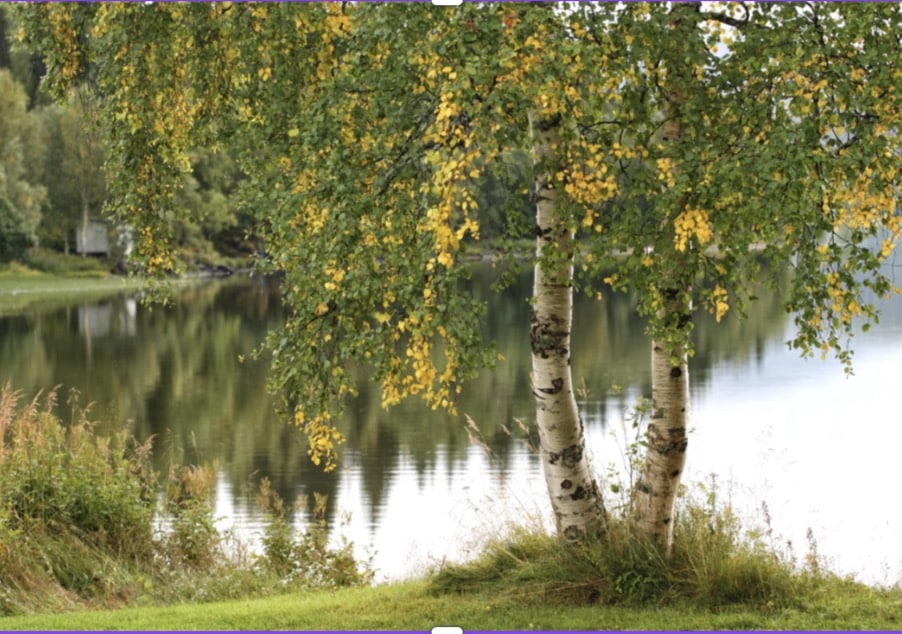
The River Birch (Betula nigra) is a fast-growing, medium-sized tree, reaching 40-70 feet with a broad, irregular crown.
Native to eastern North America, its glossy green leaves and distinctive, peeling bark create striking appeal. Ideal for wet or low-lying areas, it tolerates flooding and urban conditions but dislikes drought.
Moderately long-lived (50-100 years), it supports birds and small mammals. Plant in moist soils for its vibrant fall color and unique bark texture.
14. Sweet Birch
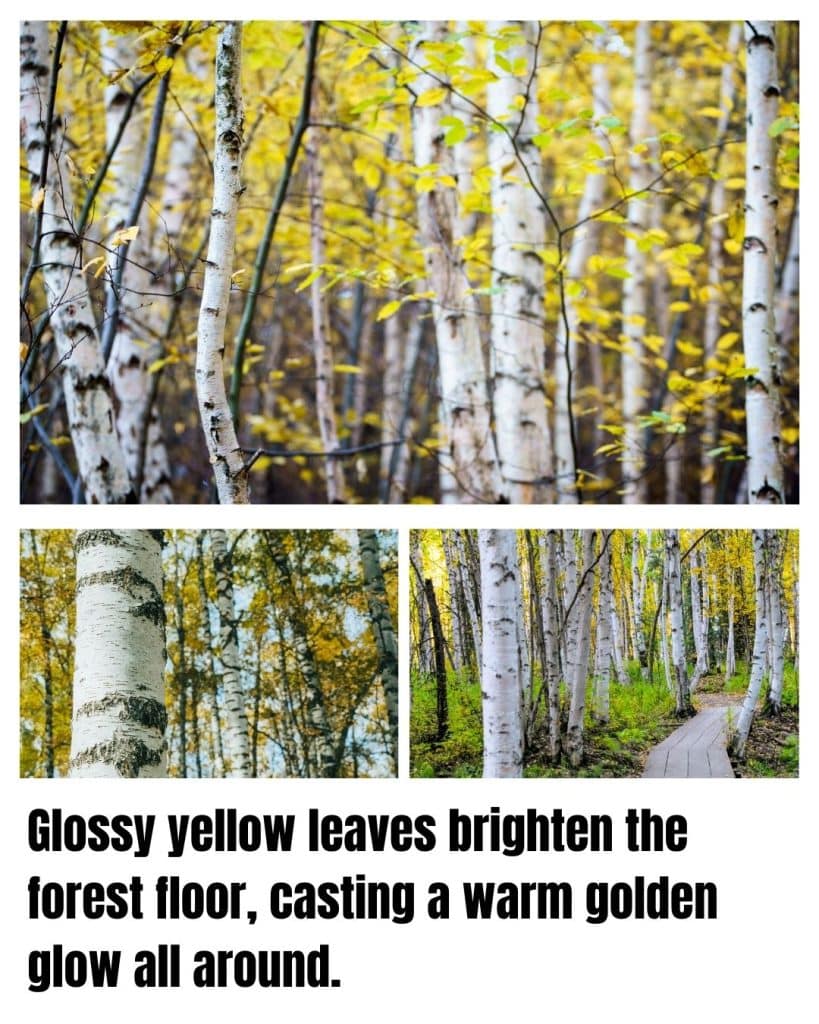
- Thrives in: USDA hardiness zones 3-7, native to northeastern United States, preferring cool, moist, well-drained soils in full sun to partial shade, often in upland forests.
- Leaf show: Oval, serrated leaves turn bright yellow to golden in fall, peaking in October, creating a glowing canopy that contrasts with its dark bark.
- Trivia: Its bark and leaves, when crushed, emit a wintergreen scent; historically, its sap was used to make birch beer and medicinal oils.
The Sweet Birch (Betula lenta) is a medium-sized, deciduous tree, growing 40-70 feet with a rounded crown.
Native to eastern North America, its glossy green leaves and shiny, dark reddish-brown bark add elegance. Ideal for woodland gardens or open spaces, it tolerates cold climates but struggles in heat or drought.
Moderately long-lived (up to 100 years), it supports wildlife like birds. Plant in cool, moist soils for its vibrant fall color and aromatic charm.
15. Crepe Myrtle
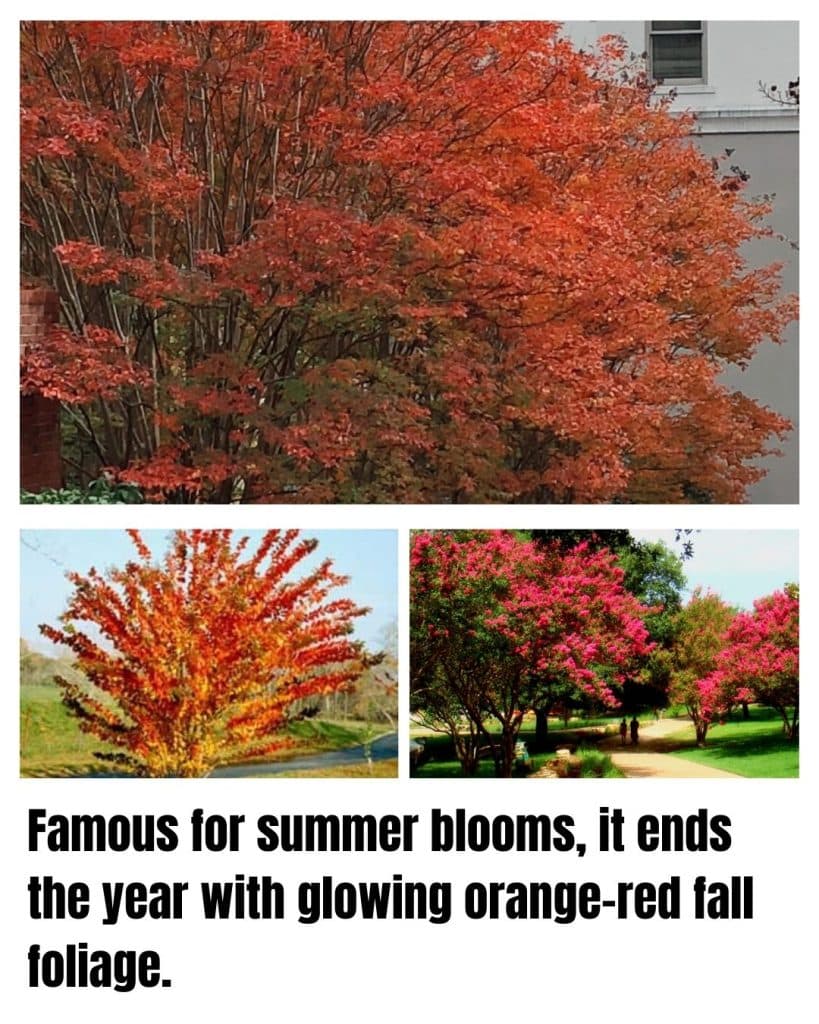
- Thrives in: USDA hardiness zones 6-9, native to Southeast Asia but widely planted in southern United States, preferring well-drained soils in full sun, tolerant of heat and drought.
- Leaf show: Oval leaves turn vibrant red, orange, or yellow in fall, peaking in October to November, complementing its colorful summer blooms for extended beauty.
- Trivia: Its smooth, peeling bark reveals mottled hues; often called the “lilac of the South,” it’s a staple in southern gardens for its multi-season appeal.
The Crepe Myrtle (Lagerstroemia indica) is a small to medium tree or shrub, growing 15-30 feet with a spreading crown.
Its glossy green leaves and vibrant summer flowers (pink, red, or white) make it a landscape favorite. Ideal for small gardens or urban settings, it tolerates poor soils and heat but needs full sun.
Relatively long-lived (50-100 years), it attracts pollinators. Plant for its stunning fall color and year-round ornamental charm.
16. Chinese Pistache

- Thrives in: USDA hardiness zones 6-9, native to China, preferring well-drained soils in full sun, highly adaptable to urban conditions, drought, and poor soils.
- Leaf show: Pinnate leaves turn brilliant orange, red, and scarlet in fall, peaking in November, offering a fiery, reliable display even in warm climates.
- Trivia: Female trees produce small red berries that turn blue, attracting birds; it’s a popular street tree due to its resilience and non-invasive roots.
The Chinese Pistache (Pistacia chinensis) is a medium-sized, deciduous tree, growing 30-60 feet with a rounded, spreading crown.
Its glossy, compound leaves and smooth gray bark add year-round appeal. Ideal for urban landscapes or small yards, it tolerates heat, drought, and pollution but prefers well-drained soils.
Long-lived (up to 150 years), it supports wildlife like birds. Plant for its vibrant fall color and low-maintenance, adaptable nature in diverse settings.
17. Redbud
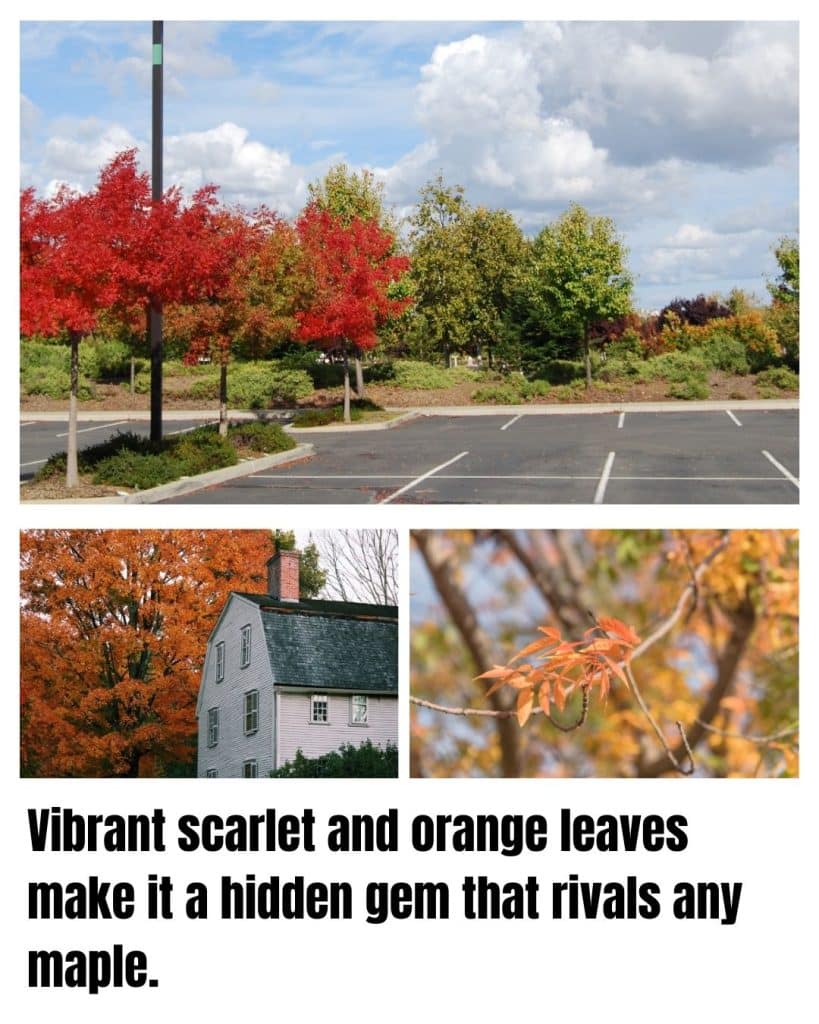
- Thrives in: USDA hardiness zones 4-9, native to eastern and central North America, preferring well-drained, moist soils in full sun to partial shade, adaptable to various conditions.
- Leaf show: Heart-shaped leaves turn bright yellow to golden-orange in fall, peaking in October, complementing its vibrant spring pink-purple blooms.
- Trivia: Its small, pea-like flowers are edible and were used by Native Americans in salads; the tree is a larval host for several butterfly species.
The Redbud (Cercis canadensis) is a small, deciduous tree, growing 20-30 feet with a rounded, spreading crown.
Native to North America, its glossy green leaves and smooth gray bark add charm. Ideal for small yards or woodland edges, it tolerates clay soils but prefers moist, fertile conditions.
Moderately long-lived (50-70 years), it’s a pollinator and wildlife magnet. Plant for its stunning spring blooms and vibrant fall color in diverse landscapes.
18. Smokebush
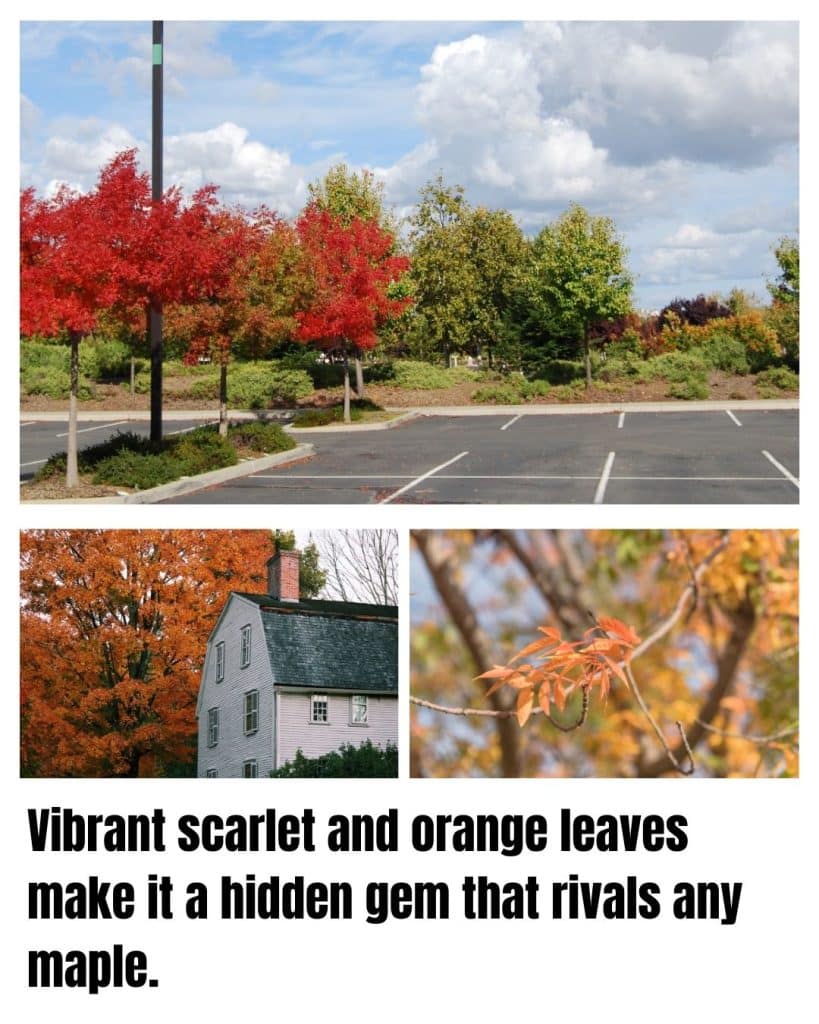
- Thrives in: USDA hardiness zones 4-8, native to Europe and Asia, preferring well-drained, fertile soils in full sun, adaptable to poor soils and urban conditions.
- Leaf show: Rounded leaves turn vibrant red, orange, or purple in fall, peaking in October, with airy, smoky flower plumes adding summer texture.
- Trivia: Its fluffy, smoke-like flower clusters give it its name; some cultivars, like ‘Royal Purple,’ retain deep purple foliage year-round.
The Smokebush (Cotinus coggygria) is a small tree or large shrub, growing 10-15 feet with a rounded, spreading form.
Its colorful foliage and wispy, pinkish flower heads create multi-season appeal. Ideal for small gardens or mixed borders, it tolerates drought and rocky soils but prefers full sun for best color.
Moderately long-lived (50-70 years), it attracts pollinators. Plant for its dramatic fall color and unique, smoky summer blooms.
19. Witch Hazel
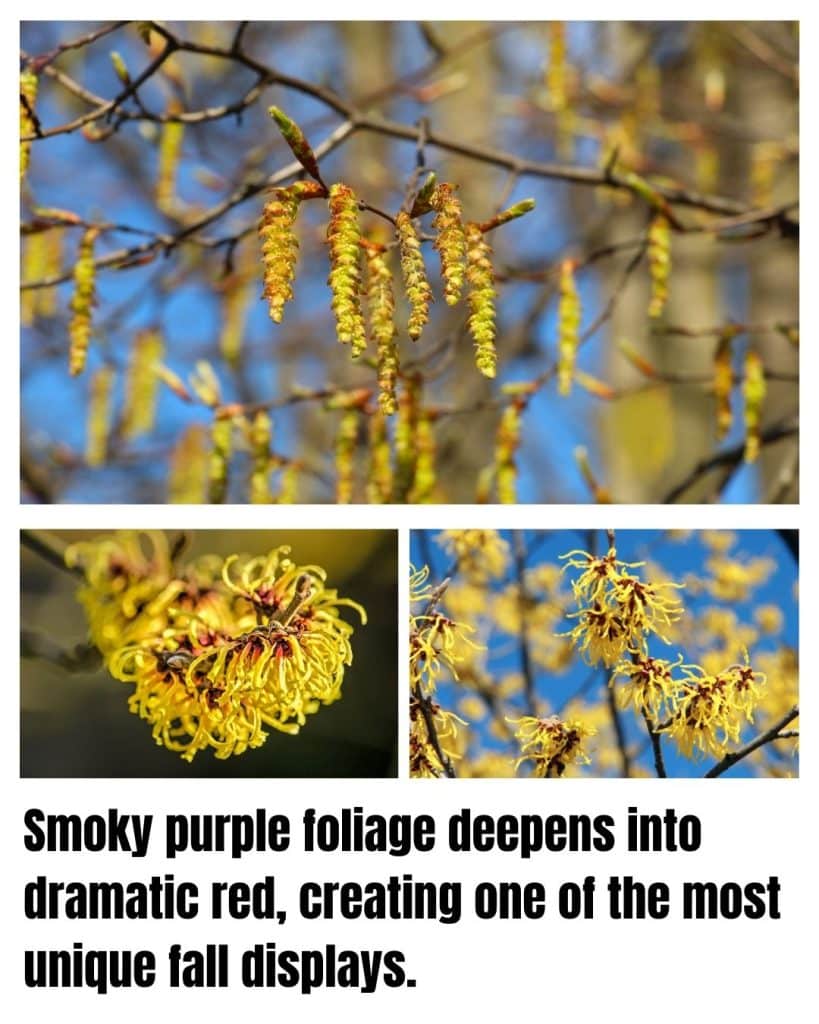
- Thrives in: USDA hardiness zones 3-8, native to eastern North America, preferring moist, well-drained, acidic soils in partial shade to full sun, adaptable to woodland edges.
- Leaf show: Oval leaves turn bright yellow to golden-orange in fall, peaking in October, often accompanied by fragrant, spidery yellow flowers for a unique dual display.
- Trivia: Its extracts are widely used in skincare for anti-inflammatory properties; the name comes from “wych,” an Old English word for pliable, referring to its flexible branches.
The Witch Hazel (Hamamelis virginiana) is a small tree or large shrub, growing 15-25 feet with a vase-shaped or rounded form.
Native to eastern North America, its green leaves and smooth gray bark add subtle appeal. Ideal for small gardens or naturalized areas, it tolerates clay soils but prefers consistent moisture.
Long-lived (up to 100 years), it attracts pollinators with late-blooming flowers. Plant for its unusual fall blooms and vibrant foliage in shaded landscapes.
20. Katsura
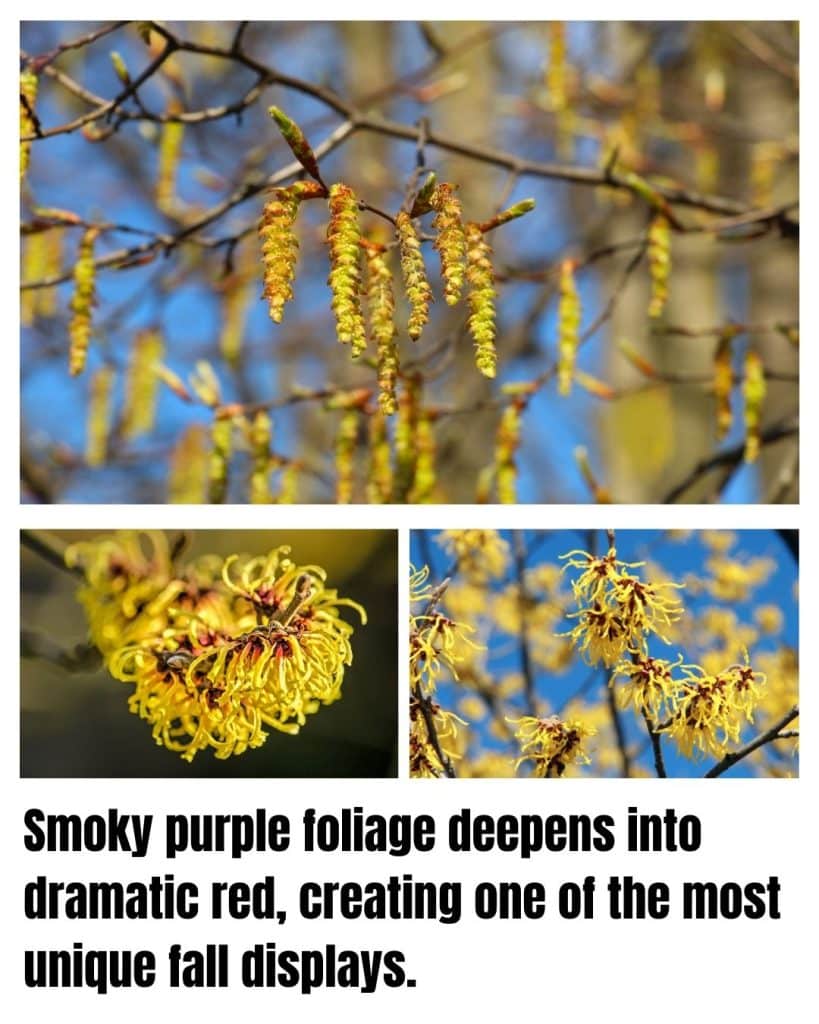
- Thrives in: USDA hardiness zones 4-8, native to Japan and China, preferring moist, well-drained, slightly acidic soils in full sun to partial shade, ideal for temperate climates.
- Leaf show: Heart-shaped leaves turn vibrant yellow, orange, pink, or red in fall, peaking in October, often releasing a sweet, caramel-like scent as they change.
- Trivia: The falling leaves emit a fragrance reminiscent of cotton candy or burnt sugar, making it a sensory delight in autumn gardens.
The Katsura (Cercidiphyllum japonicum) is a medium to large deciduous tree, growing 40-60 feet with a pyramidal or rounded crown.
Native to East Asia, its blue-green leaves and smooth gray bark add graceful appeal to any landscape.
Ideal for spacious landscapes, it tolerates urban conditions but prefers consistent moisture and protection from wind.
Slow-growing and long-lived (up to 150 years), it supports minimal wildlife but offers unique aromatic charm. Plant in fertile soils for its stunning, scented fall display.
21. Fothergilla
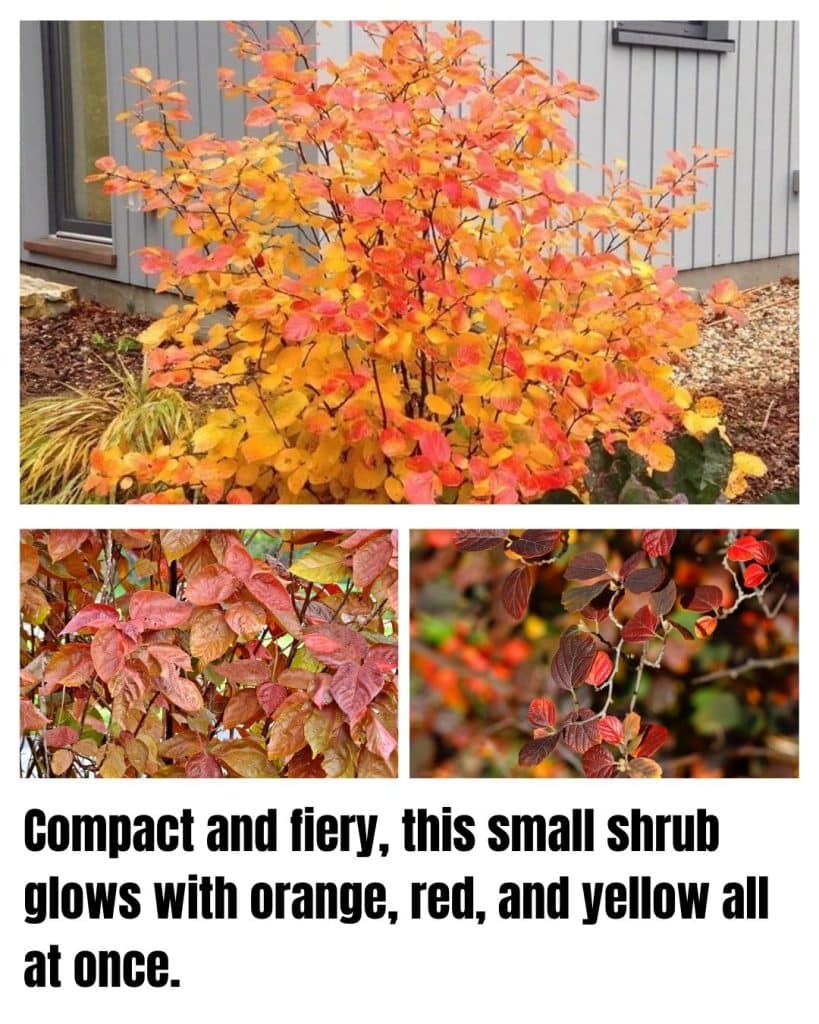
- Thrives in: USDA hardiness zones 4-8, native to southeastern United States, preferring moist, well-drained, acidic soils in full sun to partial shade, ideal for woodland gardens.
- Leaf show: Oval leaves turn brilliant red, orange, and yellow in fall, often blending multiple hues on a single plant, peaking in October for a fiery display.
- Trivia: Its fragrant, bottlebrush-like white flowers bloom in spring, attracting pollinators; it’s named after English physician John Fothergill, an 18th-century plant enthusiast.
The Fothergilla (Fothergilla gardenii or major) is a compact, deciduous shrub or small tree, growing 3-10 feet with a rounded, dense form.
Native to the Southeast, its leathery green leaves and twiggy structure add subtle charm. Ideal for small gardens or borders, it tolerates wet soils but prefers consistent moisture.
Long-lived (50-80 years), it supports bees and butterflies. Plant for its vibrant fall color and fragrant spring blooms in shaded or sunny settings.